Photos by Justin Fort and Jaime Hernandez
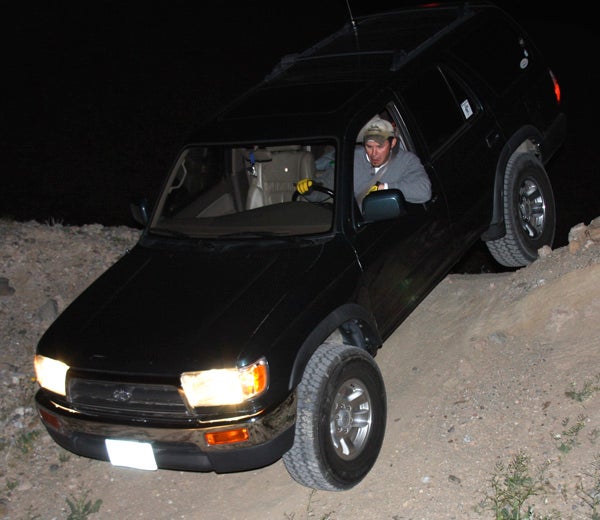
The Marines have a saying about preparation, skill and effort when the sit-rep goes S.N.A.F.U. (can’t remember the grisly details), but what do you say when things are so easy that doom patrol turn out to be unnecessary? A good Marine would probably suggest being prepared is an “always” sort of thing, so this might be more a case of crisis averted than a bad day for Charlie.
Root of 4Runner Braking DifficultiesIf you are among the few people on Earth who have not driven a 4Runner, you should be advised that a recurring sore spot is underperforming brakes. It’s a genetic defect, a rare chink in the typically excellent Toyota armor. Outsider solutions come and go, but so many of them turn out to be a Band-Aid: grabbier pads or slightly better metal in the rotors will not change the overall size of the rotor-to-pad interface, nor the inherent thinness of the rotor itself (a crucial element of the heat dissipation necessary for repeated effective braking).
Yep, we’ve overheated the brakes of our 4Runner. After a big off-ramp stop, they went from relatively smooth to all bendy. The warpage would go away after cool-down, and it would return after another heavy stop. Seems the rotors would overheat and deform, then cool and straighten, over and over again, a clear indication they were not coping well with the heat generated during stops.
The 4Runner is not the heaviest truck. In fact, it only weighs about 3850 lbs., give or take the automatic trans (add 45 lbs.) or Limited trim (95 lbs. more). It’s far less than other trucks in its segment – the similarly sized Dodge Durango weighs more than 4800 lbs. That said, 4Runners are still sloppy stoppers. Is there a real solution? You bet your pasty white ass there is.
PAGE 2
How to Improve 4Runner Brakes – Make Them Tundra Brakes
Some Toyota tech or gearhead probably held up a Tundra brake caliper to a 4Runner bracket, or noticed the 4Runner and Tundra rotors were the same diameter. Genius frequently needs a nudge for inspiration to hook, and in a moment the Tundra swap was born. Hell, it could have been planned all along by Toyota, or parts were used across truck lines to save costs. Perhaps the 4Runner caliper bracket was used during Tundra prototyping. No matter, swap’s on.
Consider the math: Tundras weigh up to 4200 lbs., and they’re designed to work like a truck (and be abused like one), so the brakes need to be more effective. The 4Runner, for all its Jeepy competence, was designed with less workload in mind and more to satisfy the job of SUV- wagon than a “truck” truck. This could have been at the expense of certain dynamic capacities.
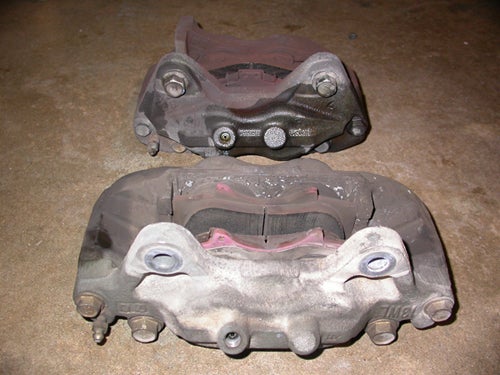 |
| The difference in caliper sizes – dinky 4Runner and 231mm Tundra – is crystal despite the Tundra unit being up front. You can see “13WL”stamp on the right. Be careful to compress the pot straight in, not at an angle. Fluid will shoot out, so cover the line port. |
There are two calipers from the first-generation Tundra that will bolt up to the gen-three (1996-02) 4Runner. Both do a much better job hauling 3900 lbs. of 4Runner to a stop, including the original 199mm Tundra caliper. The 199 was deemed insufficient to suitably slow the early Tundras (prone to fade and warpage – sound familiar?). A service bulletin (back-door recall) was issued for Tundras made through 2002, and lots of 199mm calipers were swapped for a larger, beefier and heavier 231mm unit that was OEM on later 2002 Tundras (as part of the mid-model redesign). To Toyota’s credit, the new 231mm caliper and pad combo worked much better.
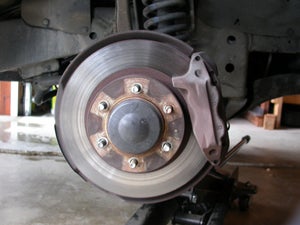 |
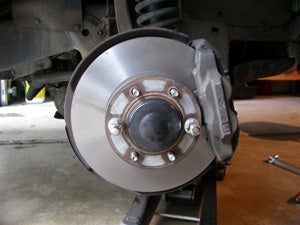 |
| 4Runner VS Tundra brakes, before and after – simple. The 231mm caliper required a little more trimming of the dust shield and the wheel. |
For your needs, find a Toyota dealership with an amicable service department and you might be able to locate good-enough-for-4Runner 199mm calipers. Should no 199s be available, that selfsame parts department can order you loaded 231mm Tundra calipers and the matching rotors right out of stock, and you’ll have brand new hardware with a warranty. You can also scrounge the boards on SoCalTundra or Yotatech or countless other Toyota-only Web sites, or search a junkyard for wrecked Tundras and Sequioas (admittedly, a grand adventure in its own right). Junkyard calipers and rotors will need to be examined closely for defects. Our 231s came from a 2002 Tundra being built for pre-runner duty, but it took some hunting – next time, we buy new.
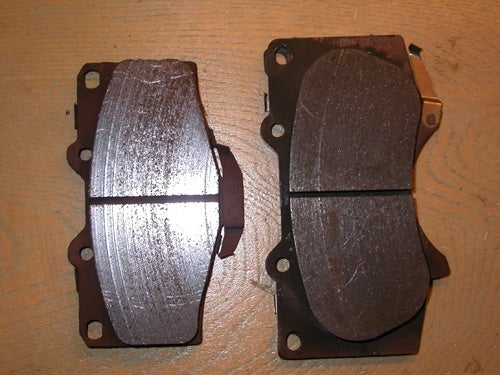 |
| Pad to pad, the Tundra unit offers at least 15 percent improvement in contact plus much more backing plate to better transfer heat away from the friction surface. |
Identifying gen-one Tundra calipers: the 199 has “S13WE” stamped on it, while the 231 wears “13WL.” The Tundra rotor didn’t change post-recall and is the same diameter as on a 4Runner, but the Tundra rotor is at least 5mm thicker than the 4Runner’s. More metal distributes the heat of braking better (as does the improved pad-to-rotor contact). Tundra rotors use 5mm more stud.
PAGE 3
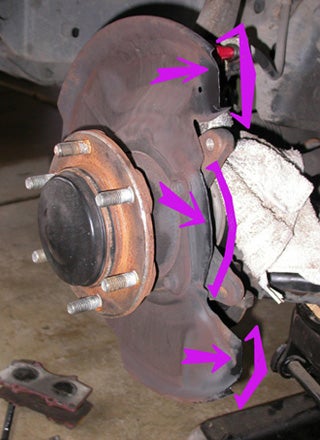 |
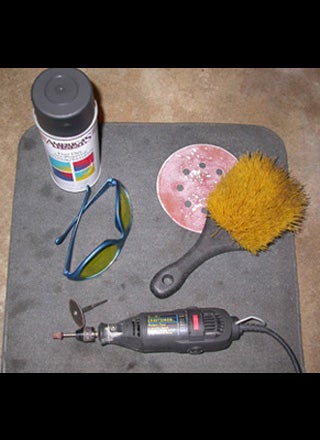 |
| Trim as shown – about 5mm off the middle, about 3cm off the upper and lower tips. A short list of tools is needed; snips would work, but we were feeling surgical. You can find Dremel-friendly cutoff discs at the swaps. Don’t forget the Krylon. |
Four Bolts, Four Fittings
This installation is one of those bolt-on jobbies that makes you ask repeatedly “What did I forget?” It’s almost easy enough to do with a beer assist. Alright, we do not advocate getting blotto while working with pointy tools or things that could kill you (like the weight of a 4Runner – always use jack stands), but short of trimming the splash shield and taking a grinder to the back of your wheels (if you use the ubiquitous cast-aluminum split-three Toyota 16-inch), complications are unnecessary. Keep in mind, 15-inch wheels will not fit over Tundra brakes. The 4Runner bolts will hold the Tundra caliper. The 4Runner brake line will screw into the Tundra caliper (don’t forget your flare wrenches and brake cleaner). The 4Runner hub fits the Tundra rotor. The hardest part of this monstrous improvement in braking for 4Runners will probably be getting the Tundra parts (unless you’ve never bled brakes, which is tricky – ask someone how beforehand).
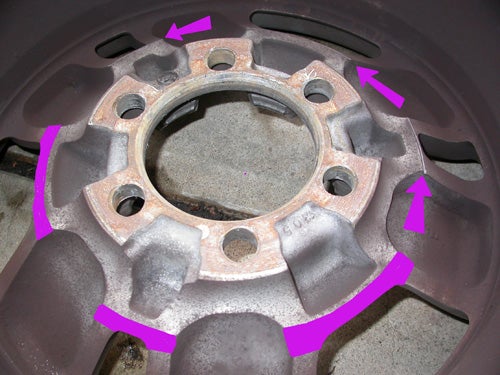 |
| You’ll be grinding the split-three spoke 16” where indicated, all the way around – we did a little interference-fit check first. A 5mm spacer should work too, but you’ll be getting short on stud (no pun intended). |
Tune in next time for a rundown of how the Tundra binders bite, plus a layout of the Tundra-based lift going into this truck care of Toyota Racing Development, Bilstein and, well, we haven’t decided what springs are going in back. It’s complicated, and we’ll explain.
For the first part on our 4Runner build, click here.


 Your Privacy Choices
Your Privacy Choices